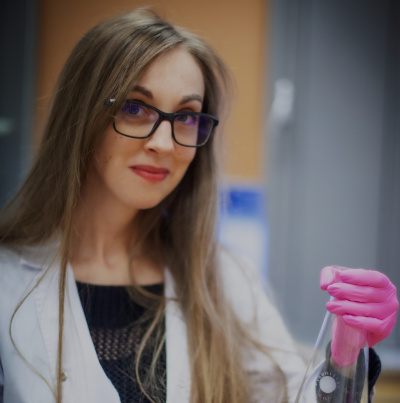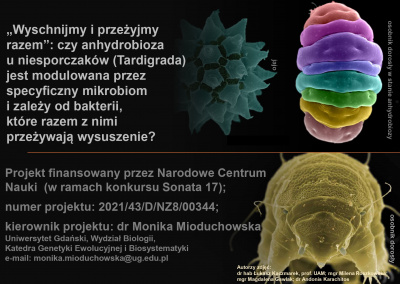Pioneering research on 'indestructible' tardigrades is being conducted by an inter-university team of scientists, including, among others, dr Monika Mioduchowska from the UG Faculty of Biology. The group is headed by dr hab. Łukasz Kaczmarek, prof. UAM. A publication prepared by the researchers on the cosmopolitanism of one of the most interesting extremophiles appeared in the journal 'Scientific Reports' from the Nature Publishing Group. ‘Our goal was to verify the hypothesis “Everything is everywhere”,' dr Monika Mioduchowska said about the article.

Marcel Jakubowski: - Tardigrades are the subject of extensive research, not just biological ones. What makes these creatures so interesting to scientists?
Dr Monika Mioduchowska: - That's right, tardigrades (Tardigrada) arouse the interest of scientists worldwide and are the subject of numerous studies. These microscopic invertebrates, measuring just 0.01 to 1.2 mm, inhabit all ecosystems on all continents. Because of their microscopic appearance, which resembles small bears, one of their common names in English is water bears.
Tardigrades are widely regarded as the most resilient animals on Earth. This is due to their remarkable capacity for cryptobiosis, which enables them to go into anabiosis, i.e. a state of latent life. This occurs when the conditions in which they exist become unfavourable. It is thanks to cryptobiosis that they can survive in extreme environmental conditions: in a very wide range of temperatures (from absolute zero to over 150°C), in high doses of UV and ionising radiation, in very low and very high atmospheric pressure, and in a state of dehydration.
Amazingly, tardigrades can even survive the vacuum of space. Thus, they have also become a model object in astrobiological research. However, to date, despite extensive investigation, the mechanisms of cryptobiosis on molecular and physiological grounds are poorly understood. Also of great interest is the so-called 'Sleeping Beauty' hypothesis, which assumes that during latent life, tardigrades do not age. Research into the description and identification of new tardigrade species is also widespread.
In the publication you cited, we undertook to verify the 'Everything is everywhere' hypothesis. This hypothesis assumes that local environmental conditions, rather than mobility capabilities, determine the distribution of microscopic organisms. As a result, when analysing the distribution of the species in question, we can expect it may be cosmopolitan, as in the case of the species Paramacrobiotus fairbanksi studied at the morphological and genetic level, which has been recorded in Albania, Antarctica, Spain, Canada, Madeira, Mongolia, Poland, the USA, and Italy. I encourage you to read this publication.
- What is your role in the research team?
- I am a member of an interdisciplinary research team led by dr hab. Łukasz Kaczmarek, prof. UAM from Adam Mickiewicz University in Poznań. As a molecular biologist, I am involved in the genetic part of the research, which is mainly focused on integrative taxonomy, i.e. combining the results of analyses carried out at the molecular and morphological level to comprehensively describe tardigrades species new to science.
I started my adventure with these mysterious organisms in 2018. At that time, I was conducting parallel research on, among other things, phylogenetic analyses and identification of endosymbiotic bacteria and microbiome analyses of other systematic groups - bivalves (Bivalvia) and crustaceans (Crustacea). At that time, information on endosymbiotic bacteria and the microbiome associated with tardigrades was like a tabula rasa in the world literature.
Thus, we decided to start pioneering experiments. During our research, the first paper by a tardigrade team from Italy - which described the microbiome of several tardigrade species – was published. Our publication on this subject was the second one. There is still a lot of inspiring and interdisciplinary research ahead of us, which I hope will allow us to make scientific discoveries.
Some discoveries have already been published by our team. We have identified infections with an endosymbiotic bacterium of the Wolbachia genus in several tardigrade species. This bacterium is of great interest to scientists because the mechanisms of its effect on the host are very complex, and it significantly disrupts the biology of its host. This occurs by manipulating the reproduction process. Infections by this endosymbiont have been discovered thanks to new molecular and bioinformatics tools developed by our team, which have also allowed the discovery of Wolbachia in other systematic groups of invertebrate organisms. Here, I would also like to encourage you to read the publication.

- Will you continue your research on tardigrades or cosmopolitanism?
- Of course! In 2022, I received grant funding from the National Science Centre (under the Sonata 17 competition) for the project 'Let's dry out and survive together: is anhydrobiosis in tardigrades (Tardigrada) modulated by a specific microbiome and dependent on bacteria that survive drying out together with them?’. Until now, no one at the University of Gdańsk has dealt with tardigrades. Thus, I am currently setting up a research team to study this systematic group.
I will talk about the project in a nutshell. Let me stress at the outset that the research being carried out is pioneering. When talking about the unusual properties of tardigrades, I mentioned cryptobiosis. One type of cryptobiosis is anhydrobiosis, a state of desiccation in which tardigrades can survive for up to a dozen years. However, what makes these microscopic organisms seemingly indestructible is unknown. Do they owe their unique abilities to the microbiome inhabiting their body? To answer this question, several experiments will be carried out, one of which is to analyse the microbiome associated with different species of tardigrades at different stages of their development, starting with the egg, through pre- and post-anhydrobiosis adults, as well as individuals at the anhydrobiosis stage.
Species with varying success associated with anhydrobiosis and even those in which this unusual ability is not recorded are studied. Analyses are being carried out by metagenetic sequencing.
As a result of the research, species-specific bacteria in tardigrades at a particular developmental stage will be identified, as well as bacteria that may be responsible for the ability of tardigrades to anhydrobiosis. If bacteria do indeed play an important role in anhydrobiosis, our research will be groundbreaking in understanding this phenomenon. It is possible that the findings could also have more complex applications. Finally, I would like to encourage anyone interested in collaborating to get in touch. There are many more adventures ahead of us, with mysterious tardigrades.
